The purpose of this article is twofold. It is to list those pieces which are or were often confused as patterns in the past as well as list pieces which may have been deliberately struck for sale to collectors. Many of these pieces have Judd and/or Pollock numbers. Others are listed in the back of Judd in appendix B. In many cases, the error pieces listed are rarer and more valuable than the die trials they are confused with. Items are listed by year.
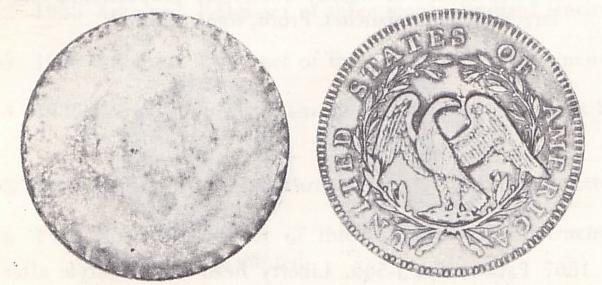 P3007
P3007
This is a striking of the regular 1795 half dollar Overton reverse H on a regular silver lettered edge planchet. It is believed to be a mint error as opposed to a true die trial.
It is unique and is ex B. Haines (Bangs, Merwin & Co 1/1863 lot 783, Woodward 5/1863 lot 2182, Appleton, MHS-Stacks 3/73, Bowers and Ruddy 2/74, Crouch-Superior 6/77.
Photo is a scan from the Bowers and Ruddy 2/74 sale.

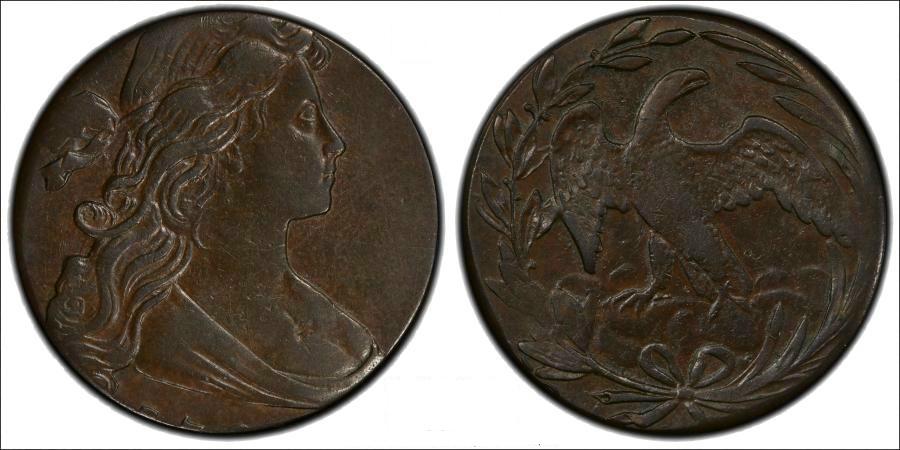 P34
P34
This famous piece is a 1795 draped bust silver dollar from dies not known to be used on any regular issue silver pieces. It is struck on a 96 grain copper planchet (per PCGS) with the diameter of a Large Cent, and is from dramatically rotated dies.
The piece is unique and is ex Woodward 4/1863, Parmelee (New York Coin & Stamp 6/1890), Woodside (New York Coin & Stamp 4/1892), Woodin-1914 ANS, Newcomer, Boyd, Kosoff 7/1951 Numismatic Gallery Monthly, Kosoff 5/1955, Hydeman-Kosoff 3/1961, Stacks 5/1975, private collection, Lustig, Byers, private collection. It is graded PCGSAU55.
Various explanations for the coin's existence have been proposed. Adams and Woodin listed it as AW18 and called it a die trial piece. Judd listed it as a mint error. (Now under review.) Stack's called it a "setup trial piece to insure (sic) the striking distance between the obverse and reverse dies" in their 5/75 sale. (Saul Teichman disagrees because it is not as thick as a dollar planchet. He also notes that the Mint was able to create full size dollar planchets in copper for the 2 1794 dollars J18/P27 and J19/P28, and that all other die trials of this year are full-sized as well). Andy Lustig argues that it is either a die trial on an undersized planchet, a die trial on a full size copper planchet that was later cut down for use as a large cent planchet, or (most likely) a mint sport that could have been struck anytime from 1795 to 1863.
Photo courtesy of PCGS.
 1795 Eagle on Large Cent Planchet
1795 Eagle on Large Cent Planchet
This piece is mentioned in Judd but not imaged. It is ex Newcomer, Kosoff's July-August 1951 edition of Numismatic Gallery Monthly, Kosoff 5/55 lot 594, Bolt-Stacks 4/66 lot 1725 where it is noted as defaced with 7 dents.

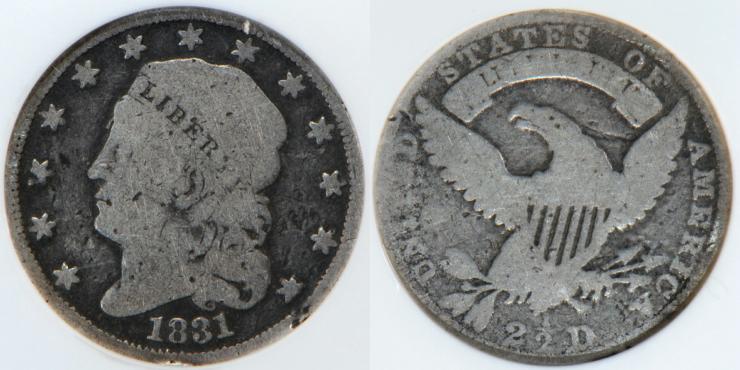 J49/P50
J49/P50
Although listed by Judd as a regular dies trial piece struck in silver, Taxay describes this as a mint error, struck on a dime planchet which your editor believes is the more likely scenario.
Only 2 are confirmed:
1) Heritage 9/08 sale - NGCG6, illustrated above courtesy of Andy Lustig.
2) McCoy (Woodward 5/1864), Cohen (Cogan 10/1875), Roberts, unknown intermediaries, H Chapman 6/6/1898, V. Brand (journal id #18625), Armin Brand, consigned to FCC Boyd on 7/19/40 returned, consigned to Stacks on 7/8/41 who placed it in their August 1941 Opezzo sale, Farouk, Judd, Sloss, Mocatta-79 ANA as MS63 withdrawn, Mocatta-StacksBowers 8/22 - PCGS VF details, tooled, illustrated below courtesy of StacksBowers.
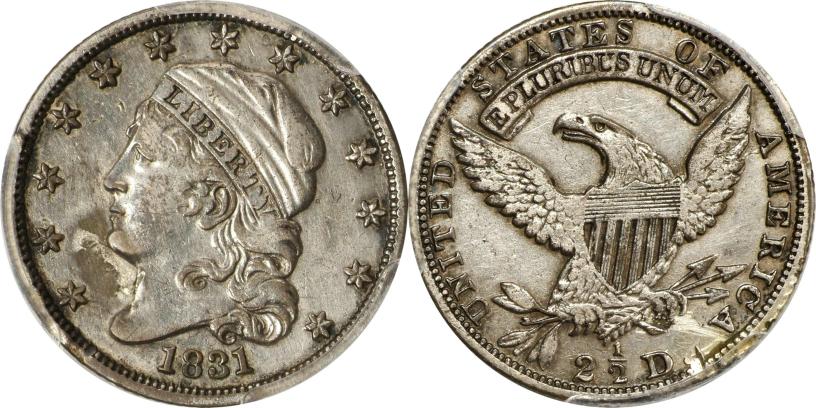
This coin clearly matches the Judd plate in the
Illustrated History of U.S. Coins.

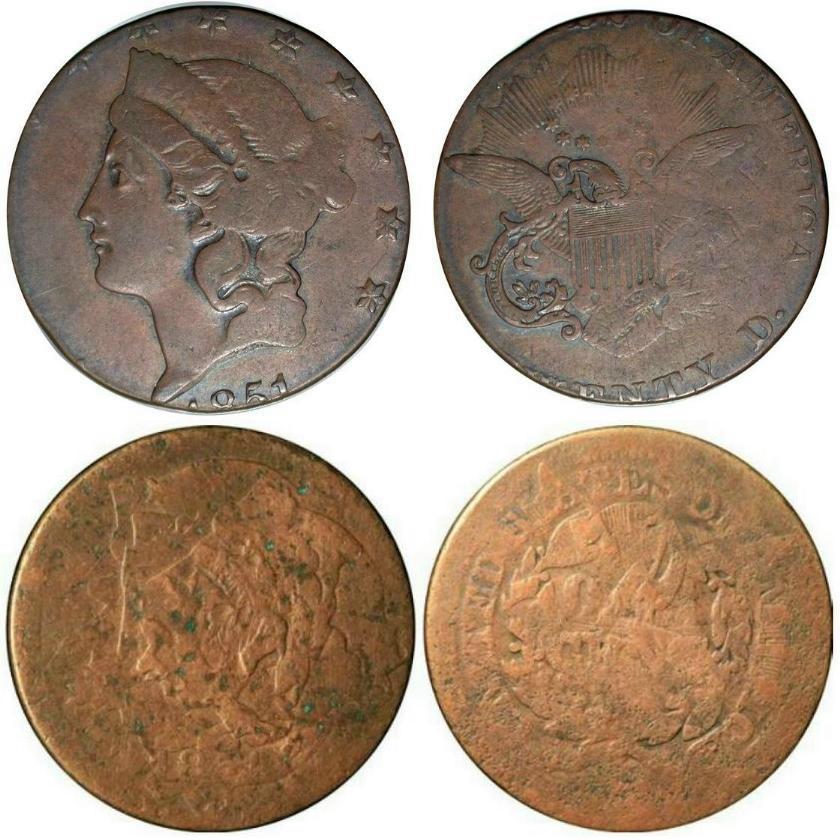 1851 $20 on Cent
1851 $20 on Cent
This is an example of an 1851 Double Eagle struck on a large cent planchet. It has been listed in appendix B as a mint error in all editions of Judd.
It is unique and is ex Woodin-1914 ANS exhibit - where described as "Regular dies of the Twenty-dollar pieces struck on copper planchet size of Ten-dollar piece", Newcomer, several Kosoff sales in the 1950s, Judd, Kaplan, Weinberg, Byers (1975 FPL), Weinberg and has been in the Mark Lighterman collection since the late 1970s. It grades NGCXF45BN.
The piece was the subject of an article in the January 29, 2018 edition of Coin World.
A similar piece, considered a die set up piece, is known that was struck 3 times at different angles from double eagle dies, then twice from half dollar and finally from large cent dies. It appeared in the October 2017 edition of Penny Wise by Ed Fuhrman. It is entirely possible that both pieces were die setup pieces. Both are illustrated here.
Photos courtesy of David Camire & Ed Fuhrman.

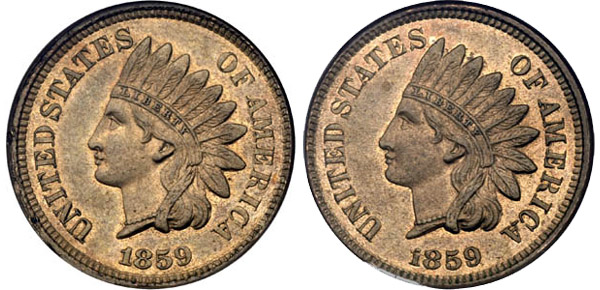 J229A/P273A - 2 Headed Muling
J229A/P273A - 2 Headed Muling
This two-headed muling, a business striking - not a proof, was recently rediscovered and was the subject of an article in the September 18, 2000 edition of Coin World.
This coin is almost certainly the piece which was sold as lot 1532 of S. H. Chapman's May 1914 sale of the Gable collection where it realized $20.00 - a huge sum for that time. It was purchased by Edgar H. Adams of Adams and Woodin fame.
It was later listed as AW318A in Green and Hewitts 1940 Priced Catalog of US Pattern Coins. It was also listed in the Mule section of Taxay's 1976 Comprehensive Encyclopedia.
We have assigned it the following Judd and Pollock numbers J229A/P273A. It is important to note that a followup article in the October 2 edition of Coin World describes this piece as a possible mint error.
The coin's recent pedigree is Chicago Mid-American coin convention, 6/2000; John R. Schuch; Superior, 10/2000, lot 4017A; Heritage July 2008 ANA, Simpson-Heritage 9/20 - PCGS62.
Photo courtesy of Superior.

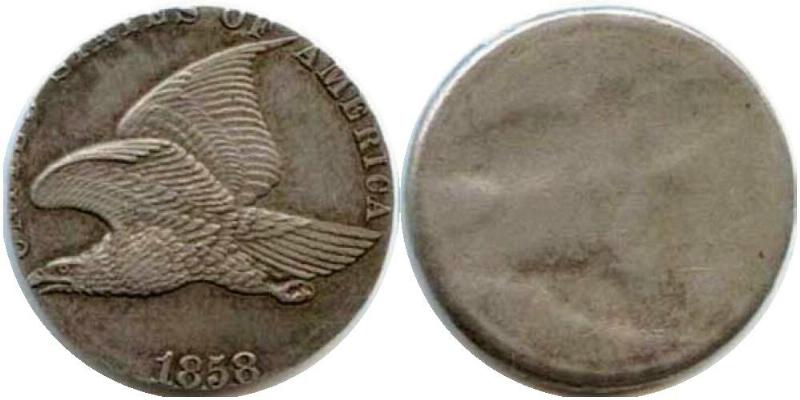 AW249
AW249
This famous error show the obverse of the 1858 flying eagle cent with small letters struck uniface on a half dime planchet. This is believed to be a piggy-back planchet which rested on top of a cent blank when this was struck. It was listed in the Adams and Woodin book as a pattern.
It is similar to another mint error P3188 which was struck in a similar manner but over a struck half dime.
The piece is unique and is ex-Scott 7/1880 lot 474, Woodside, Woodin, Brenner-1914 ANS, Brand, Ruby-Superior 2/74, NASCA 10/79, Schornstein, HIM 11/82, Cowell, Lighterman collection - NGC63
Photo courtesy of Mike Byers.

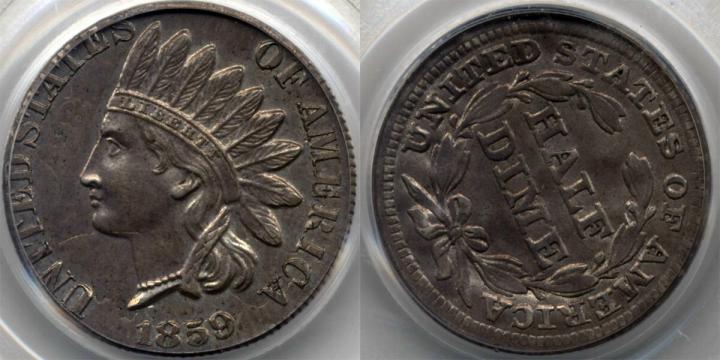 P3188
P3188
Although listed as an obverse die trial in silver for the 1859 Indian head cent struck over a struck 1857 half dime planchet, it is more likely a mint error in which this struck half dime ended up on top of a blank cent planchet resulting in the striking seen above. The half dimes date can be seen in the field to the left of the Indian's face under the "STA" in "States".
A similar piece is AW249 which was struck over a blank half dime planchet. This overstrike is unique and is ex B. Haines 1/1863 lot 870, Seavey (1873 Descriptive Catalog #951), Parmelee (1890), Ruby-Superior 2/74, Bowers and Merena 4/86, Stacks 11/08.
Photo courtesy of Mike Byers.

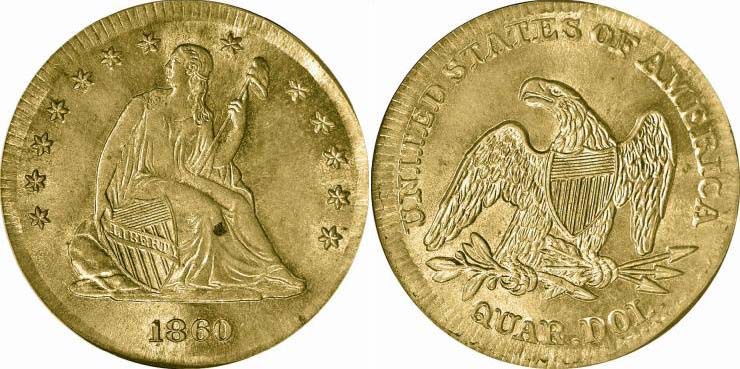 J268/P316
J268/P316
Although described as a regular dies trial piece in copper-nickel, it is more likely a mint error struck on an 1856 experimental half cent planchet for J177/P205, per Stacks 9/86, or a copper-nickel cent planchet.
Only a single example is confirmed ex Woodin-1914 ANS exhibit, Newcomer, Farouk, Paramount 11/73, NASCA 11/77, Stacks 9/86.
Photo courtesy of ©2010 Whitman Publishing, from 100 Greatest U.S. Error Coins.

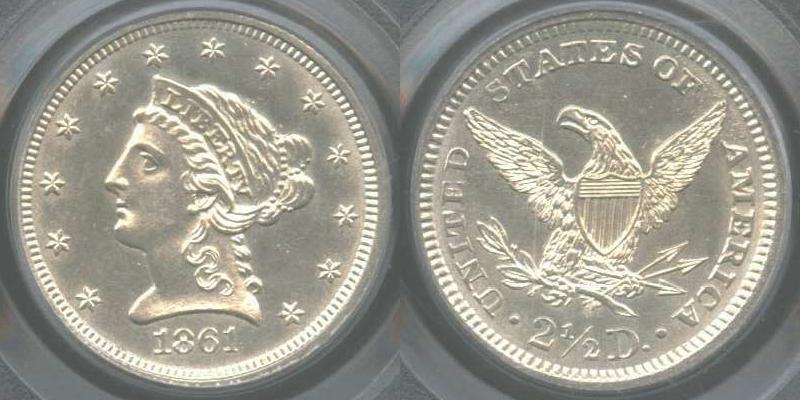 J281/P332
J281/P332
Although listed as a die trial, struck in silver, in the reference books for years, this is actually a mint error struck on a dime planchet from business strike dies.
The following 3 pieces are confirmed from 2 different obverse dies:
1) Bluestone 9/42, Taylor-NN61st 6/70, Bass-HWBRF, B/M 5/99, Heritage 4/02, Simpson-Heritage 2/21 - PCGS63, illustrated above. This has the first one in date roughly centered between Liberty's neck and the dentils.
2) Leidman 9/71, Bass, HWBRF-Heritage 5/23 - PCGS63, this and the next have the first one in date closer to Liberty's neck.
3) Woodside, Woodin, Newcomer, Farouk, RARCOA 4/72, RARCOA 1/73, Stacks 8/76 ANA, unknown intermediates, LegendAuctions 1/28/2018, GreatCollections.com 2/12/23, GreatCollections.com 8/6/23 - PCGS61, lacquered
One of the last 2 is from Federal Coin Exchange's 8/57 ANA (blue steel toned) and/or Bolt-Stacks 4/66 (toned).
Photo courtesy of Heritage.

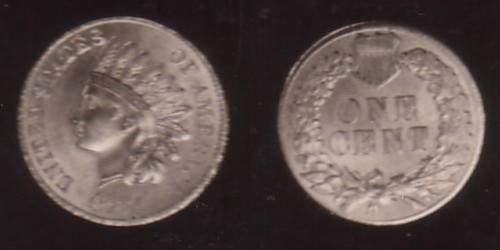 Indian Cents on Nickel Planchets
Indian Cents on Nickel Planchets
The Judd, Pollock and Adams and Woodin books contain many listings for Indian cents struck in either nickel or copper-nickel that are not patterns. These pieces, especially those after 1876 from business strike dies, are actually mint errors struck on either 3 cent nickel planchets or one of the following foreign planchets:
| Country | Denomination | Diameter | Weight | Composition |
|---|
| Venezuela | 1 cent | 19 mm | ~36.5 grains | copper, nickel, zinc |
| Dominican Republic | 5 cen | 18 mm | 32.4 grains | copper 75%, nickel 25% |
| Colombia | 5 cent | 20 mm | 48.8 grains | copper 75%, nickel 25% |
| Nicaragua | 5 cent | 19.8 mm | 44.8 grains | copper 75%, nickel 25% |
| Haiti | 5 cent | 19.8 mm | 44.8 grains | copper 75%, nickel 25% |
| Costa Rica | 10 cent | 18 mm | 30.9 grains | silver 90%, copper 10% |
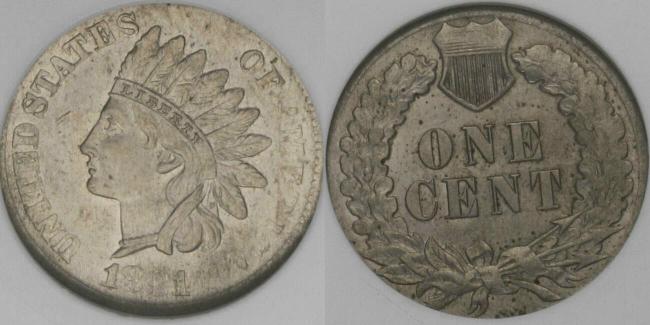
Those struck on the smaller 3 cent nickel planchets, as on the 2 1881 illustrated pieces above, will show some of the peripheral design missing whereas those struck on one of the foreign planchets such as the 1877 below will appear full-sized.
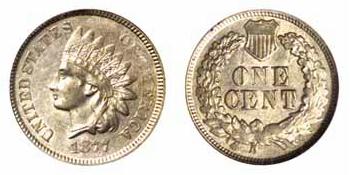
The following table list the years where at least some or all of the known nickel / copper-nickel pieces are actually mint errors.
| Date | Pollock | Judd | Additional Comments |
|---|
| 1865 | P473, P475 | J404, J406 | Judd reports one on 3 cent planchet, probably ex Bluestone 10/37 |
| 1869 | P745-P746 | J669-J670 | AW826, Taxay reports 2 pieces on 3 cent nickel planchets |
| 1871 | P1177 | J1042A | Pollock lists one on 68.25 grain planchet. |
| 1872 | P1321, P1323 | J1180, J1182 | Judd reports one on 3 cent nickel planchet ex Gable, Olsen, Lohr, and another at 49 grains (Colombian 5 cent?) also ex Gable, Olsen sales |
| 1873 | P1398 | J1257 | ex Gable, Olsen sales - 49 grains (Colombian 5 cent?) |
| 1874 | P1491 | J1346A | ex Stacks 1/87, Heritage 7/22, weight not known |
| 1876 | P1597 | J1451 | believed to be struck on Venezuelan 1 cent planchets |
| 1877 | P1648-P1649 | J1495-J1496 | Struck on Venezuelan 1 cent planchets (36.5 grain) as illustrated above and/or Dominican Republic 5 centavo planchets (32.4 grains) |
| 1879 | P1776 | J1583 | see Elder 12/16/1908 lot 972, Lohr FPL, Federal Brand 10/61, & 1/62. One is on 49 grain Colombian 5 cent planchet |
| 1881 | P1868 | J1664 | AW1657, on 3 cent nickel planchet, 2 examples are illustrated above, one of these likely ex Elder 12/16/1908 lot 975 |
| 1884 | P1932 | J1723A | Probably struck on either a Haitian 5 or Nicaraguan 5 cent planchet |
| 1888 | N/A | N/A | Probably struck on Colombian 5 centavo planchet. Apparently ex S.H. & H. Chapman 1905 Morris sale lot 397, later Heritage 8/2021, Heritage 3/24 |
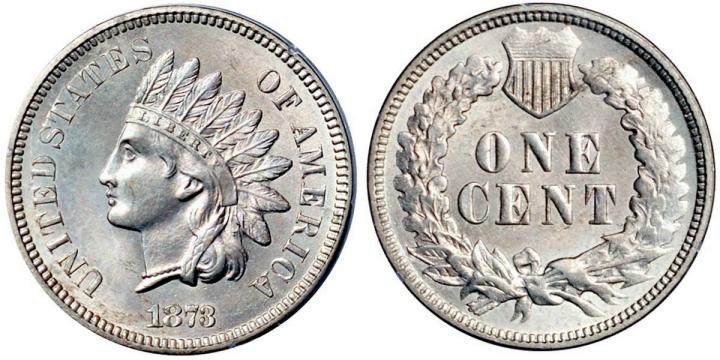
Other dates not listed may also be as well. We recommend collectors examine these pieces carefully. The 2 1876 pieces, which are imaged at the top of this webpage, were struck from different obverse dies.
Photos of the 1873 J1257/P1398 courtesy of American Numismatic Rarities, the 1876 J1451/P1597 courtesy of Superior, the 1876 on 3 cent courtesy of Heritage, the 1877 J1495/P1648 courtesy of Bowers and Merena and the 2 1881s on three cent nickel planchets are courtesy of Saul Teichman and Heritage.

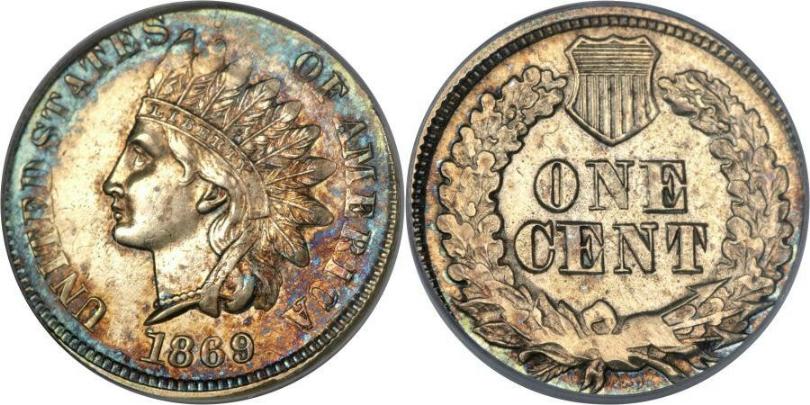 Indian Cents on Dime Planchets
Indian Cents on Dime Planchets
Indian Cents struck on silver dime planchets were often offered as patterns in early, circa 1900, auction sales.
Note that the planchet, beside being silver, is too small to house the entire periphery of the Indian cent design.
The following examples are known or reported:
- 1863 ex Kagin 6/68 lot 718, 77 ANA lot 4479, B/R 6/78 lot 1379 at $450
- 1864-L (AW-467) reported by Taxay from Adams & Woodin (dubious)
- 1868 reported by Taxay
- 1869 (AW-825) ex Woodin, Brenner-1914 ANS, Brand, Olsen, Federal Brand 5/59 lot 2196 - later to Superior 9/98 lot 829 ANACS net AU50 at $5750, Tony Terranova, Mike Byers, Heritage 1/12 at $25,300- PCGSAU55 cleaned long ago, illustrated above. Supposedly unique but the piece imaged above does not appear to match the Adams & Woodin plate.
- 1883 over a struck dime, reported by Taxay
- 1893 reported by Taxay
- 1899 overstruck on an 1899 barber dime - ex Byers in 1975, stolen from Mark Lighterman in 2001 and recovered in 2009 - NGCAU53
- 1900 ex Kagin 9/67 lot 375, 77 ANA lot 4484, Schornstein, HIM 11/82 at $2,600, Xan Chamberlain - NGC66 25% off-center and double struck
- 1903 over a struck dime, reported by Taxay
- 1905 listed as stolen from Mark Lighterman
- 1906 1) Heritage 4/13 at $19,681 - NGCXF45 illustrated in 100 Greatest Mint Errors book.
- 2) Offered on Ebay 6/18 - NGCXF details reverse scratched
- 1908 Earle (H Chapman 1912) lot 2262
- One with a piece of copper struck into the head was stolen from Mark Lighterman in 2001 and recovered in 2009 - grades XF with horizontal scratch left to top of O in One on reverse.
- 1909 1) Cohen-Halpern FPL, Weinberg - PCGSAU58
- 2) overstruck on a 1906 dime, Heritage 9/06 at $37,375, Nick Brown-StacksBowers 3/13 (not sold), StacksBowers 8/13 ANA - NGC65, illustrated in 100 Greatest Mint Errors book.
Photo courtesy of Heritage.

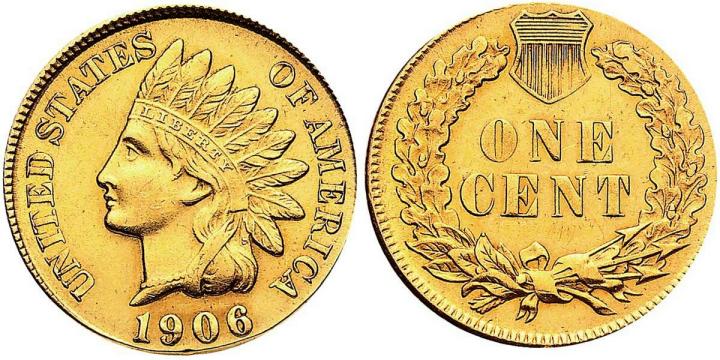 Cents on Quarter Eagle Planchets
Cents on Quarter Eagle Planchets
The Indian cent struck on a quarter eagle planchet. The year 1900 was listed by Pollock as P1990 because of the possibility that they were deliberately struck for collectors. The only problem with this is that 1900 is not the only date known.
The following dates are known:
1900 with at least 3 known.
1) Harmer Rooke 11/69 lot 3206 ?, HIM 11/82 ?, Heritage 93 ANA - AU, 67.12 grains
2) Col Green, Kreisberg 1/75, Superior Auction 89, B/M 8/91, Byers-Heritage 4/15 - PCGS65, 65.8 grains
3) reported by Mike Hodder

The earliest known purchase for one of these was the 1900 in the Dewitt Smith collection that was purchased by Virgil Brand in 1908 and entered into the Brand journals as item #46973. The Brand coin was consigned to B.G.Johnson by Armin Brand on 10/8/35 & 1/19/42 where called graded VF. It was called UNC when sent to Stacks on 3/24/42 for $210.
1905 with only one known ex Heritage 1/10 FUN, Byers-Heritage 8/14 (not sold), Heritage 12/14 (not sold), Heritage 1/15 (not sold), Heritage 4/15 (not sold), Heritage 9/15 - PCGS64 64.5 grains
1906 with only one known ex Stacks 6/04, Stacks 9/09, Nick Brown - NGCAU58, 64.4 grains
1907 with the only one known ex Kosoff, Mertes purchased at the 1952 ANA according to David Bowers' book "A Buyer's and Enthusiast's Guide to Flying Eagle and Indian Cents.
Taxay also list the following Lincoln cents in his 1976 Comprehensive Catalog:
1911 which is untraced today.
1915 ex Col Green, B.G. Johnson 1/3/1944 invoice to James Kelly, JV McDermott. This piece is listed in Pollock as P2027.
1927 which is untraced today.
Photo of the 1906 is courtesy of American Numismatic Rarities and Stacks.
Photo of the 1900 is courtesy of Mike Byers.

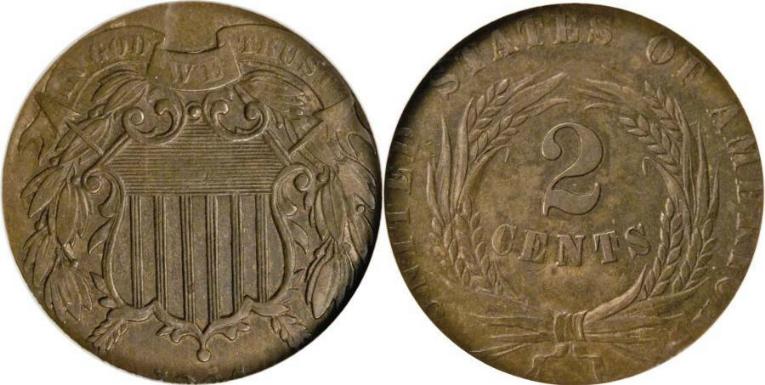 Two Cent Pieces on Cent Planchets
Two Cent Pieces on Cent Planchets
These were often misdescribed as two cent pieces struck on "rude" planchets. Examples are known for virtually every year that this short-lived series was struck as listed below.
1864 Large Motto
1) Copper Nickel - reported by Taxay
2) Bronze - Weinberg Fall 78 FPL as 1867 !!, Numismatics LTD Spring 1982 FPL, Xan Chamberlain, Heritage 1/07, Mike Byers, Heritage 4/10 - NGCAU58B
3) Bronze? - Numismatics LTD Spring 1981 FPL - AU full date
4) Bronze - Heritage 3/23 - NGCAU58BN 6607395-001 full date but weak
5) Bronze? - Bolt collection flipover on struck cent, Weinberg Summer 79 FPL - VF
1865
1) Bolt, Cohen-Halpern FPL, B/M 1/85 ch AU or better stolen from Mark Lighterman in 2001 and recovered in 2009
2) Heritage 8/15 ANA - PCGSXF45BN
3,4,5) F. Leone collection
1866
1) Kagin's 77 ANA, Schornstein, HIM 7/83 - UNC full date
2) Heritage 1/22 - NGC64BN partial date
1869 - Reported by Taxay
1871 - Reported by Taxay
No date - Byers
Photo courtesy of Heritage.

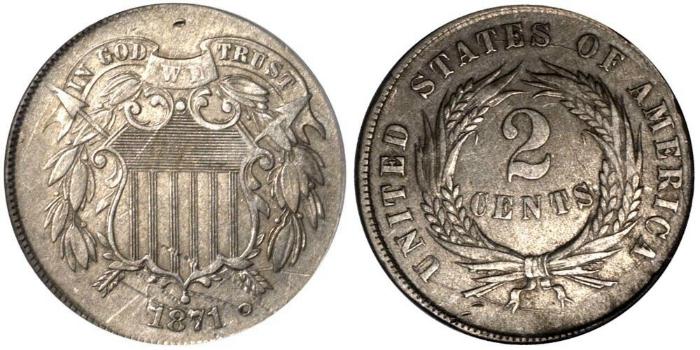 Two Cent on Shield Nickel Planchets
Two Cent on Shield Nickel Planchets
These were often misdescribed as two cent pieces struck on "rude" nickel planchets.
The following dates are reported:
1870 - per Taxay
1871 1) Weinberg 4/02 as net VF scratched, ANR 7/03 at $10,350, Northeast Numismatics, Byers, Goldberg 2/07 at $8050 (not sold), Heritage 5/07 (not sold), Weinberg FPL 2007-9 - NCS AU details, scratched, Heritage 7/09 - $4,888
2) Bolt, Cohen-Halpern FPL, Schornstein, Weinberg Summer 1984 FPL
1872 - Reported by Taxay and Judd
Photo courtesy of American Numismatic Rarities.

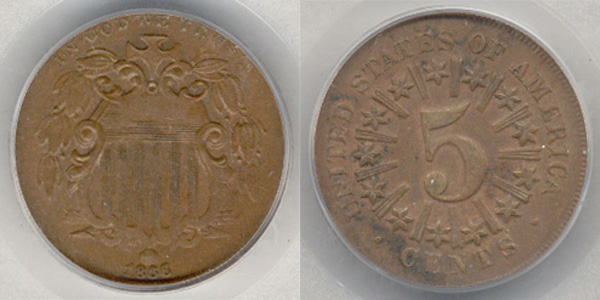 Shield Nickels on Cent Planchets
Shield Nickels on Cent Planchets
Shield nickels on cent planchets have often been mistaken for regular die trial pieces in various auction sales from the 1870s to the early 1900s.
The following dates are recorded:
1866. This is often confused with examples of J510/P594. Only 2 examples are confirmed, both of which were offered in the pattern portions of those 1800s auctions, as follows:
1) Fewsmith (Haseltine 10/1870 lot 1364), Seavey Descriptive Catalog (1873) #1048, Parmelee (1890) part of lot 165, unknown intermediates, Federal Coin 8/1960 lot 2442 as Unc, Schornstein, Lighterman - NGC64BN
2) Sanford (E. Cogan 1874 lot 80 where described as "struck on a smaller planchet and been circulated") to Herbert, much later to Federal Coin 5/1959 lot 2196 as XF?, Superior 9/98 lot 854, Jim O'donnell, Superior 2/2001, Mike Byers, Heritage 4/10 (not sold), Heritage 8/10 (not sold) - PCGSXF45, illustrated above.
Note that the entire design does not fit on the smaller planchet.
1867 with rays which could be confused with J572/P648. A single gem UNC example is known ex Fewsmith (Haseltine 10/1870 lot 1372), Seavey Descriptive Catalog (1873) #1056, Parmelee (1890) part of lot 175, much later Weinberg Summer 1979 FPL and is presently owned by Saul Teichman. It also was sold in the pattern section of the listed sales.
1867 without rays which could be confused with J573/P650. A single VF example ex Federal Coin 8/60 lot 2443 is confirmed.
1868 which could be confused with J635/P707. This is reported in Judd and Taxay but is not confirmed. The copper pattern is also unconfirmed and may be a misdescription of this mint error.
1873 which could be confused with J1264/P1406 with apparently the 2 known listed below.
1) Zabriskie (H Chapman June 1909 lot 312) to Jenkins (H. Chapman 7/22 Jenkins sale lot 1011), Olsen (Mehl 11/44), Farouk, unknown intermediates, Weinberg-Heritage 5/22 - NGC64RB
2) ANS Inventory #0000.999.55686, corroded, 2.969 grams - verification pending
1876 reported by member Fred Weinberg as ex Bolt - PCGSAU50BN.
1882 with 3 confirmed as follows:
1) Heritage 9/02 at $2,070, Weinberg, Byers, Als Coins, Heritage 1/07 (not sold) as NCS AU details, cleaned, Heritage 4/14 (now retoned) - PCGSAU55.
2) Xan Chamberlain - NGC65BN 1770620-002
3) Woloch-Heritage 7/22 - NGC64BN 2126467-003
One of these last 2 is ex Elder 2/25/09 lot 37, Elder 11/37 (a Chicago collector) lot 1189.
Photo courtesy of Mike Byers.

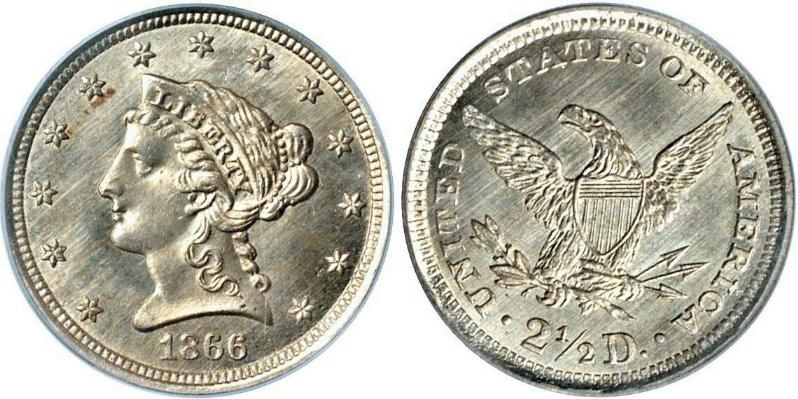 J542/P607
J542/P607
The regular dies trial piece struck in nickel. These were either deliberately struck for sale to collectors or are mint errors struck on 3 cent nickel planchets.
We can account for the following examples:
1) Parmelee-NY Coin & Stamp 6/1890, Reed-Durham Museum - ICG62
2) Heritage 8/99 ANA as PCGS66, Simpson-Heritage 11/20 - PCGS67
3) Stacks 8/76 ANA, Fairfield-B/R 10/77, Byers-Heritage 4/15 as NGC66, StacksBowers 5/16 - PCGS66, illustrated above
4) Merkin 3/68
5) MTB in 1974, T.R. Walsh, per Pollock, possibly the same as #2 or #4
The Mike Byers coin has been authenticated and certified by NGC as a MINT ERROR. It was struck on a 3 Cent Nickel planchet and graded Mint State 66 as shown below.
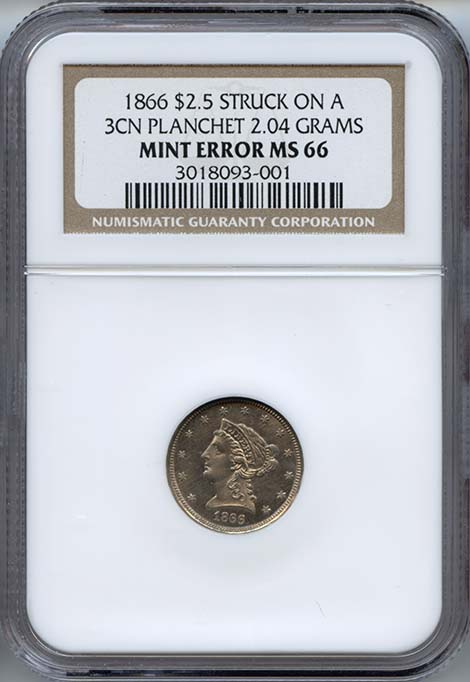
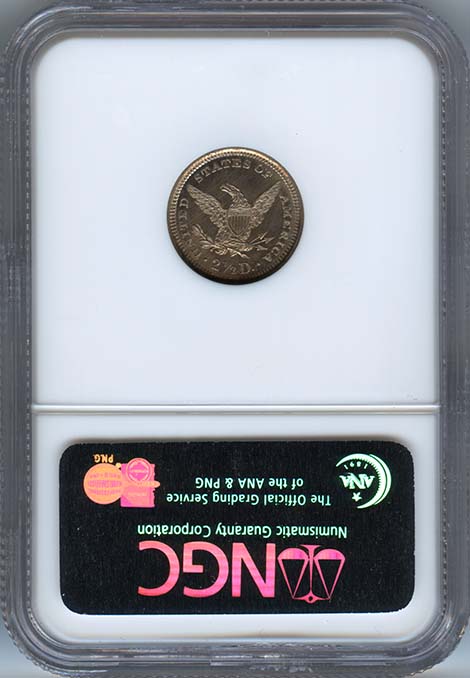
It is unclear, at this time, what the true status of these pieces really is.
Photos courtesy of Mike Byers.

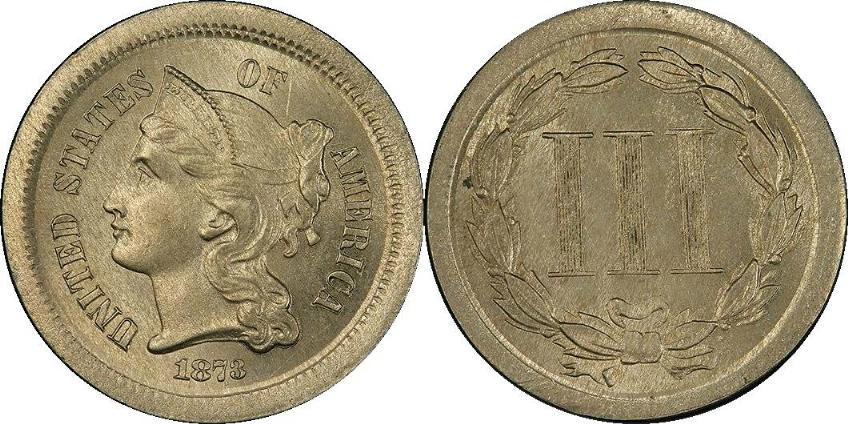 J1260A/P1401
J1260A/P1401
The following 3 cent piece was struck in nickel from regular dies and shows a broader planchet and is slightly heavy 32.4 grains which is why Pollock included it in his pattern book. The piece appears, however, to be a broadstruck mint error. The coin was originally graded NGC64 but was upgraded to PCGS65 when the coin was offered in Heritage 4/21 sale ex Simpson and reslabbed as a mint error. Because of this, the image of the coin under J1260a no longer appears on the pcgs.com/coinfacts website.
Photo courtesy of PCGS.

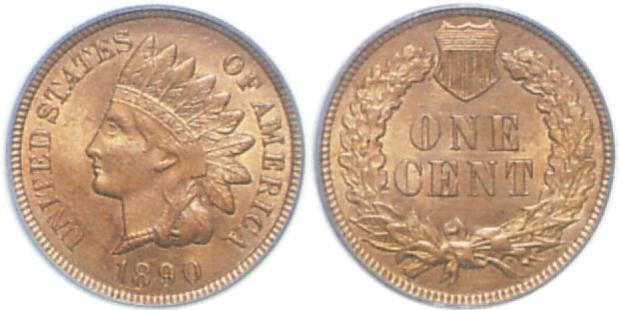 J1758/P1971
J1758/P1971
These are listed as regular dies trial pieces. Some of these may be mint errors.
Examples are listed as follows:
Copper J1757. This was delisted by Pollock. A circulated example, struck on a thick planchet, was sold in Stacks 12/97 sale and a second weighing 67.9 grains was sold in Bowers and Merena's May 2006 sale. The weight is within the tolerance for these to simply be mint errors struck on misrolled copper planchets of nickel thickness stock.
Nickel P1970A. This was unknown to Judd. Pollock lists an example weighing 46.4 grains struck in standard coin nickel (25% nickel, 75% copper) which is probably a mint error struck on a planchet for a South American or Haitian 5 cent piece.
Copper-Nickel J1758/P1971 with at least 3 known. The illustrated example above is from Heritage 1/97. Remember to click on the thumbnail image to see an enlarged picture. Two others are circulated. These are probably struck on planchets intended for a medal or foreign coin and appear to be the same as on the 1891 Liberty nickel wrong planchet mint error illustrated below.
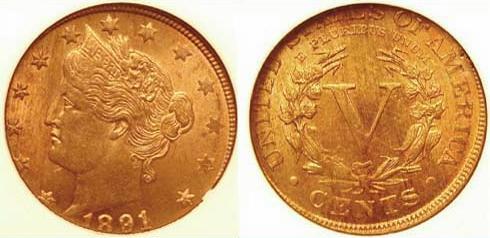
This piece is 86.9% copper and 13.1% nickel.
Aluminum J1759/P1972 which is described as unique in Taxay. We have not been able to confirm its existence.
Photos courtesy of Rich Schemmer and Heritage.

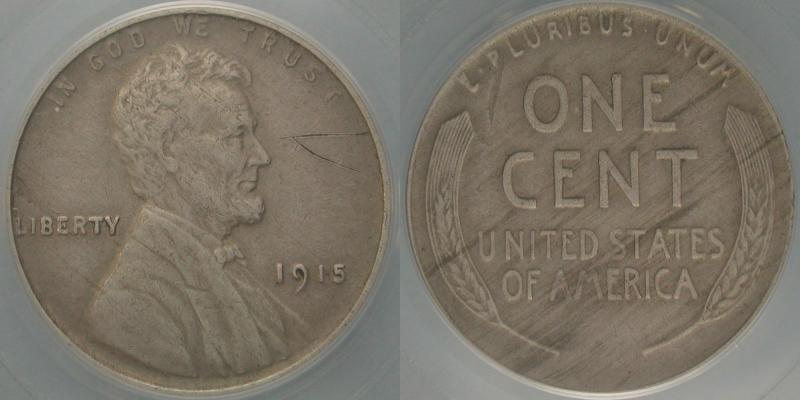 P2028
P2028
This is a 1915 Lincoln cent struck in nickel. Pollock sites the description from Elder's 2/19 sale which is as follows:
"The mint officials thinking to invent a new cent which would not rust, like the bronze one [sic], had half a dozen samples struck off in nickel. Subsequently all these trials were rejected and destroyed, except this one."
Mike Byers notes: "This fascinating piece requires further study because it weighs 50 grains and is an off-metal. A normal copper cent weighs 48 grains. The closest foreign blank which is 75% copper and 25% nickel is a 1919 El Salvador 1 Centavo, which weighs 38 grains."
We believe these explanations ares dubious. It is more likely that this is a mint error struck from planchet strip originally intended for foreign coinage - the Mint struck Cuban 2 centavos which weighed 54 grains or was struck on nickel 5 cent stock which was inadvertently rolled and punched into U.S. cent planchets. Should any exist on a 38.6 grain planchet, they would have been struck on stock for the Venezuela 5 centismo. For more on this, we recommend Mike Diamond's article for Coin World published on July 14, 2014, and titled "Scrutinize claims of experimental planchets, test strikes".
The illustrated example appeared in the June 10, 2002 edition of Coin World. It is presently owned by Michael Byers as is a recently discovered second example.
Photo courtesy of Mike Byers.

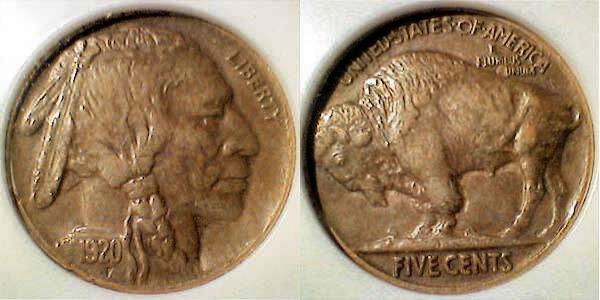 1920 5 Cent on Copper Planchet
1920 5 Cent on Copper Planchet
The following 1920 Buffalo Nickel is struck on a full size copper planchet of the same diameter, thickness, and weight of a Buffalo Nickel. Its composition is 89% CU, 8% ZN and 3% SN. The weight is 4.96 grams which is 76.54 grains. It has since been graded NGCAU50 and was last offered in Heritage's 7/02 sale and was probably struck on stock intended for a Peruvian 1 centavo.
This unique Off-Metal Buffalo Nickel is unreported in Breen, Judd or Pollock but an example does appear in the inventory journals of Eric Newman and B.G. Johnson's purchases from the Col Green collection circa 1940 as shown below courtesy of Eric P. Newman, Stuart Levine and Leonard Augsburger.

Photo courtesy of Mike Byers.

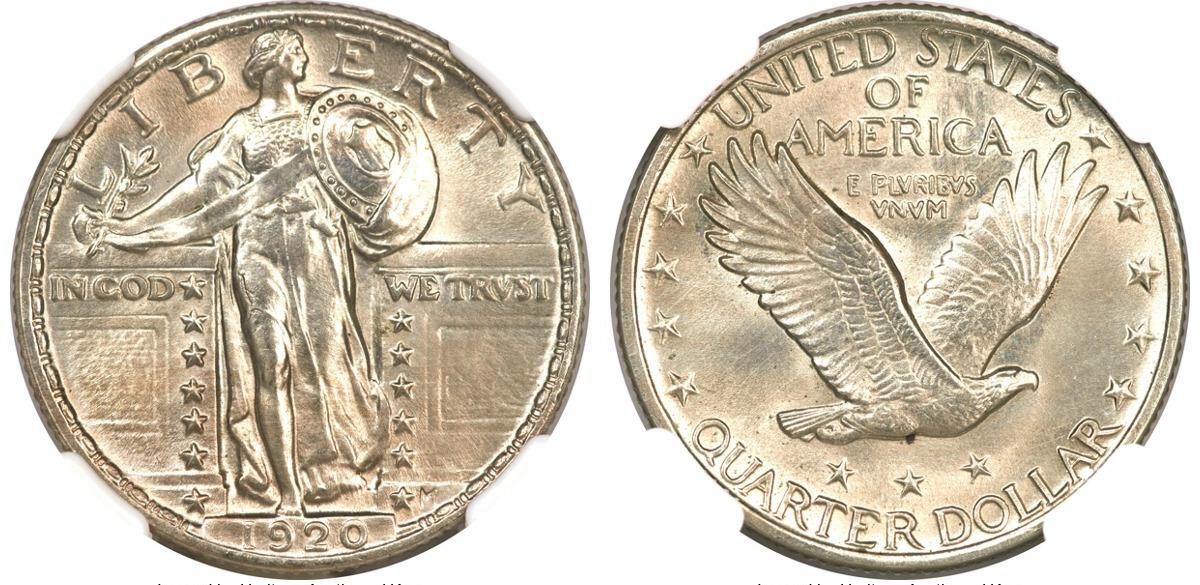 1920 Quarter on Nickel Planchet
1920 Quarter on Nickel Planchet
This coin, which is actually a Mint error struck on a Peruvian 20 centavo planchet, first appears in the inventory of the Newcomer collection as a pattern. Its later pedigree includes the Pratt collection, Federal Coin Exchange 8/60 lot 2460, Stacks 1/06 at $13,800, Mike Byers, Heritage 8/10 ANA (not sold), Heritage 3/11 at $16,100 - NGC60FH.
Photo courtesy of Heritage.

 P2078
P2078
This 1944 thick planchet specimen is more likely a mint error struck on either a foreign planchet, or on misrolled stock, ie cent planchets of either 5 cent nickel or quarter thickness. For more on this, we recommend Mike Diamond's article for Coin World published on July 14, 2014, and titled "Scrutinize claims of experimental planchets, test strikes".
To our knowledge, no analysis has been performed to see if these were struck in a special alloy. Because of this, we do not list this coin in our Pattern Concordance.
Thick planchet specimens are also known for 1941, 1942 and 1945 and many other dates.
It is unclear whether examples listed as being struck in brass or other compositions are also mint errors or some kind of wartime experiment. Further research needs to be performed with regard to these pieces.
Photo courtesy of Heritage.

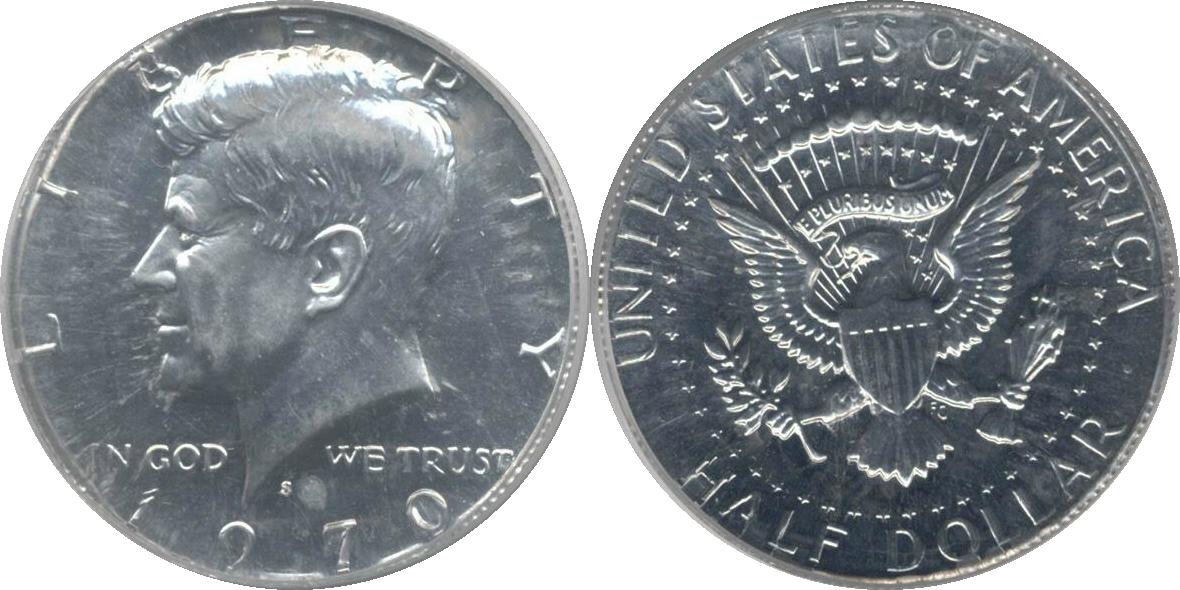 1970S Half Dollar in Aluminum
1970S Half Dollar in Aluminum
Although the 1970S half dollar above was struck from proof dies, it is not an aluminum die trial. In 1970, the San Francisco produced 3 denominations of coins in aluminum for the country of Nepal. Their thickness is about the same as a regular U.S. dime as is the half dollar above. Error dealer Jon Sullivan discovered that some of these were struck over a Missouri token issued by Shell Oil Co.
Regardless of the planchet source, these pieces were clandestinely struck. During the late 1960s and early 1970s, many suspect San Francisco Mint errors and pieces such as these were made and smuggled out to the collecting fraternity.
Eisenhower dollars on these same half dollar diameter aluminum planchets and/or tokens are also known, one of which, from the Dr. A.K. Berry collection, is illustrated in the 7th edition of Judd.
Photo courtesy of Mike Byers.

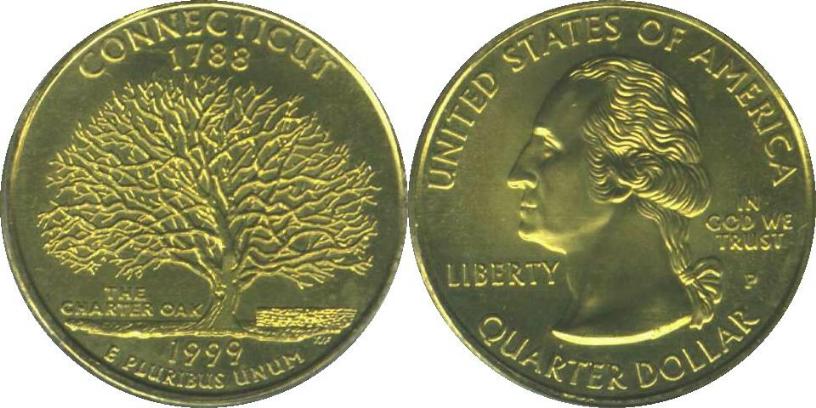 1999 Connecticut Quarter on Brass Coated Planchet
1999 Connecticut Quarter on Brass Coated Planchet
The following is reproduced courtesy of Michael Byers (member 88) of mikebyers.com.
There are approximately 15 known 1999 State Quarters struck on Experimental Planchets. All five states in the 1999 series (DE, PA, CT, GA and NJ) have been discovered.
These Experimental State Quarters have sold for as high as $10,000 each, depending on which state, the coin's condition and which type of experimental composition was used.
There are four known types of experimental compositions which have been discovered so far (November 2001) on 1999 State Quarters.
Type #1 - This type has the "color" of a Sacagawea Dollar and has a copper center core.
Type #2 - This type has the "color" of the Sacagawea Dollar but does not have a copper center core.
Type #3 - This type has a slight "green" color and has a copper center core.
Type #4 - This type has a slight "green" color but does not have a copper center core.
Here are a few "telltale" signs to determine if you have discovered a State Quarter on an EXPERIMENTAL PLANCHET in circulation:
WEIGHT - ALL examples discovered so far are OVERWEIGHT - varying from 5.9 grams to 6.3 grams.
SIZE - It will be slightly THICKER than a regular State Quarter, due to the heavier planchet.
COLOR - So far, the pieces discovered are either the same "color" as a Sacagawea Dollar, or they have a slight "green hue" to them.
LOOK - The edge is slightly rough and may have a higher rim around part of the edge.
EDGE - Some of these do NOT have a center COPPER CORE.
STRIKE - None discovered so far are proof-like in the fields.
REEDING - Some of these have incomplete reeding.
These coins were analyzed by scanning electron microscophy with energy-dispersive x-ray spectroscopy (SEM-EDX) to determine alloy composition. The predominant metal is copper, followed by zinc. There are also small percentages of manganese and nickel.
PCGS and NGC have both authenticated and certified these 1999 State Quarters as being struck on experimental planchets.
In a recent Freedom of Information Act (FOIA) request for copies of any reports and test results, the Department of the Treasury acknowledged that "the U.S. Mint conducted engineering and metallurgical tests as part of its development of an alloy for the Golden Dollar", but would not release any information.
Editor's note: It is unclear if these are truly experimental pieces or some sort of mint error. It is very possible that these were deliberately struck. We are listing them under mint errors as this sector of the collecting fraternity was the first to embrace these. We hope that further information into their true nature will appear in the future.
Photo courtesy of Heritage.

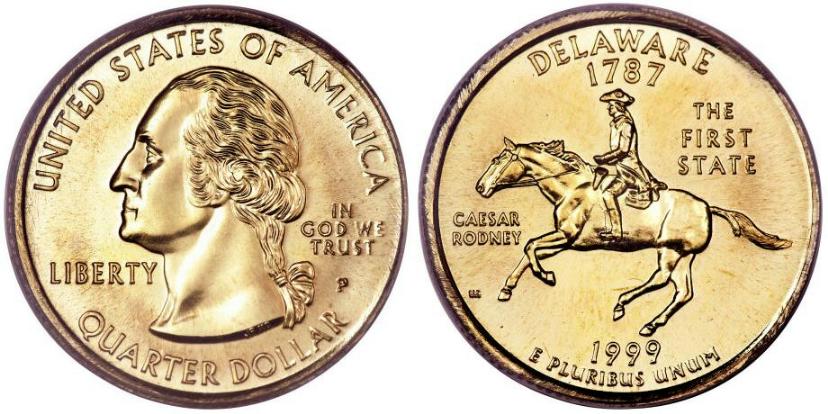 1999 Delaware Quarter on Brass Coated Planchet
1999 Delaware Quarter on Brass Coated Planchet
Photos courtesy of Heritage.

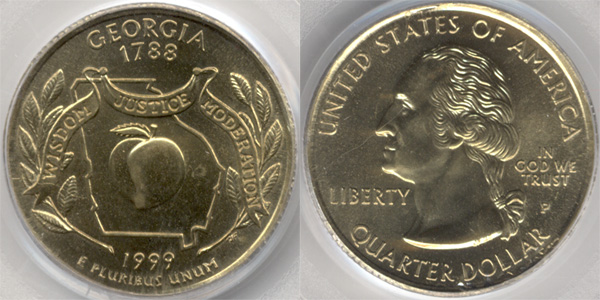 1999 Georgia Quarter on Brass Coated Planchet
1999 Georgia Quarter on Brass Coated Planchet
Photos courtesy of Mike Byers.

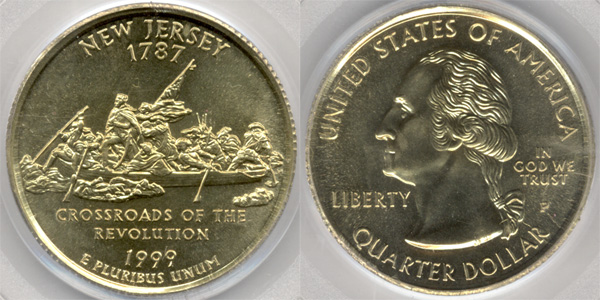 1999 New Jersey Quarter on Brass Coated Planchet
1999 New Jersey Quarter on Brass Coated Planchet
Photos courtesy of Mike Byers.

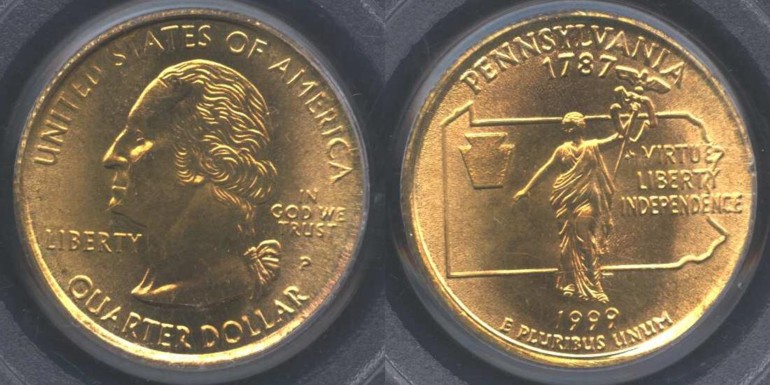 1999 Pennsylvania Quarter on Brass Coated Planchet
1999 Pennsylvania Quarter on Brass Coated Planchet
Photos courtesy of Heritage.

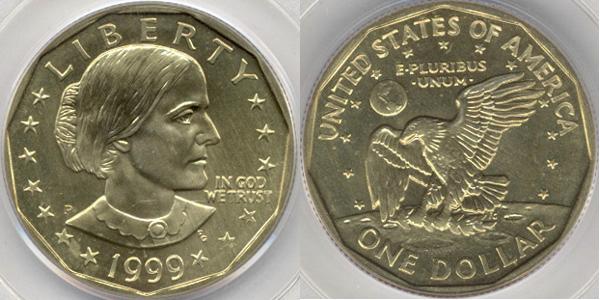 1999 SBA Dollar on Brass Coated Planchet
1999 SBA Dollar on Brass Coated Planchet
The following is reproduced courtesy of Michael Byers (member 88) of mikebyers.com.
This is an SBA Dollar struck on an experimental planchet similar to the ones found on the 1999 Experimental State Quarters were struck. These planchets are slightly different in composition from the mint errors struck on Sacagawea dollar planchets. One of these has the color of the Sacagawea dollar but does not have the copper center core. Another has a slight "green" color and has the copper center core. The third piece has a slight "green" color but does not have copper center core.
Here are some of the "tell tale" signs to determine if you have found a SBA Dollar on an experimental planchet in circulation:
WEIGHT - The weight of ALL of these discovered so far is
UNDERWEIGHT - varying from 7.3 grams to 7.6 grams.
SIZE - It is slightly THINNER than a regular SBA Dollar, due to the lighter planchet.
COLOR - So far, the pieces discovered are either the same "color" of the Sacagawea Dollar, or have a slight "green" color to them.
LOOK - The edge is slightly rough and may have a higher rim around part of the edge.
EDGE - Some of these do NOT have the center COPPER CORE.
STRIKE - None discovered so far are proof-like in the fields.
REEDING - Some of these have incomplete reeding.
LINT MARKS - One of these has several lint marks on both the obverse and reverse.
In a recent Freedom of Information Act (FOIA) request for copies of any reports and test results, the Department of the Treasury acknowledged that "the U.S. Mint conducted engineering and metallurgical tests as part of its development of an alloy for the Golden Dollar", but would not release any information.
PCGS has authenticated all three known pieces to date. The specimen photographed here is a SBA Dollar with a slight "green" color and a copper center core.
Editor's note: 2 of these have been analyzed. One with a greenish gold color was found to be 70% Copper, 28% Zinc and 2% Nickel. The second was 73% Copper, 25% Zinc and 2% Nickel. It is unclear if these are truly experimental pieces or some sort of mint error. It is very possible that these and the similar state quarters were deliberately struck using available experimental planchets for the Sacagawea dollar. We are listing them under mint errors as this sector of the collecting fraternity was the first to embrace these. We hope that further information into their true nature will appear in the future.
Photo courtesy of Mike Byers.

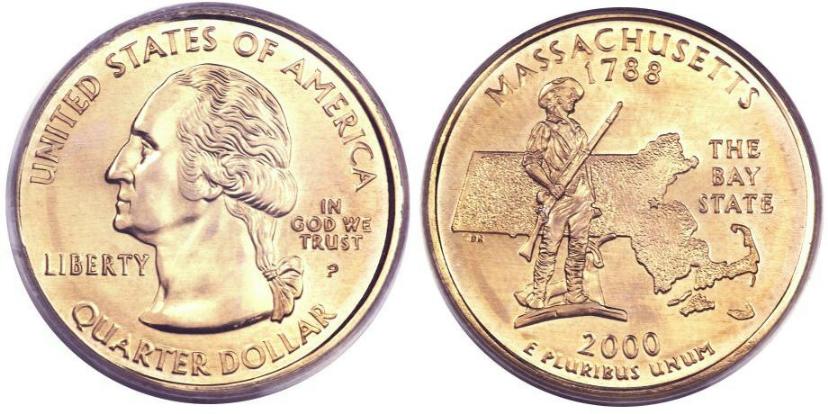 2000 Massachusetts Quarter on Brass Coated Planchet
2000 Massachusetts Quarter on Brass Coated Planchet
This piece is similar to the 1999 state quarters - Connecticut, Delaware, Georgia, New Jersey or Pennsylvania known to have been struck on Sacagawea dollar type planchets. This particular example weighs 100 grains and is ex Byers, Heritage 1/11 FUN sale.
Editor's note: It is unclear if these are truly experimental pieces or some sort of mint error. It is very possible that these were deliberately struck. We are listing them under mint errors as this sector of the collecting fraternity was the first to embrace these. We hope that further information into their true nature will appear in the future.
Photo courtesy of Heritage.

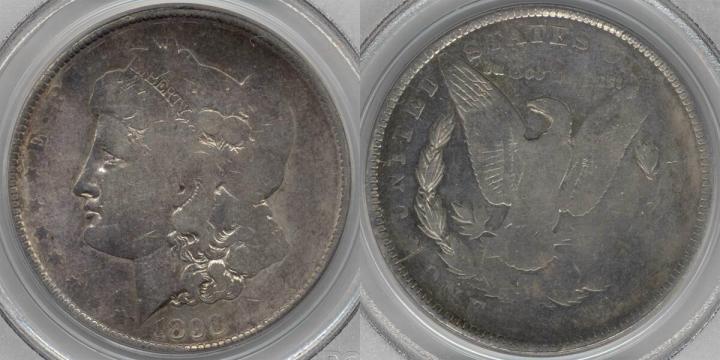 Die Adjustment Strikes
Die Adjustment Strikes
This type of mint error is very popular among some pattern collectors. On early pieces, such as the Morgan dollar above or the 2 Peace dollars illustrated below, they are believed by some to be trial pieces used to determine the proper striking pressure or the proper die spacing.
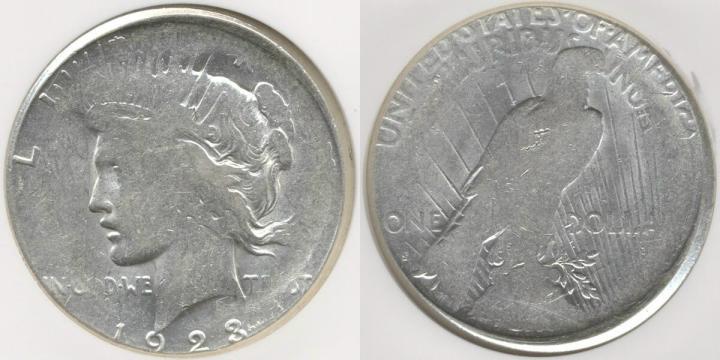
These die trials often show different degrees of striking quality as can be seen in the 2 peace dollar trials above.
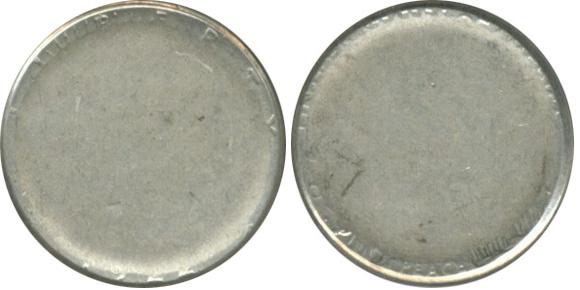
The 1877 Quarter and Walking Liberty half die adjustment strikes below show an even weaker strike than the peace dollar.
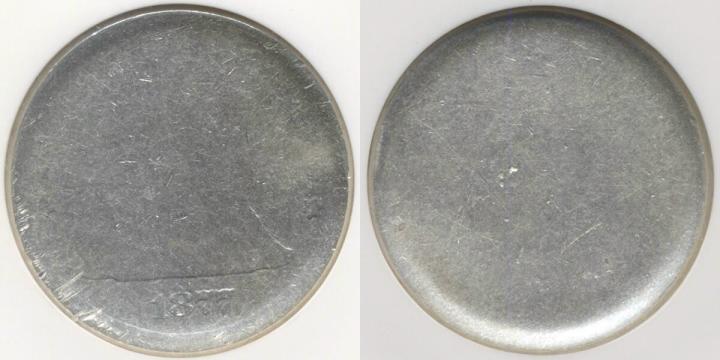
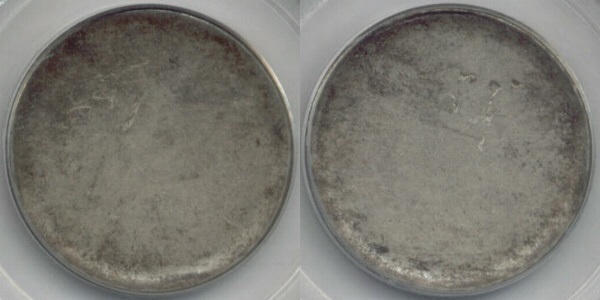
Photos courtesy of Mike Byers.

